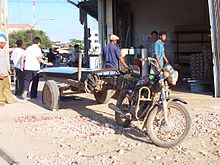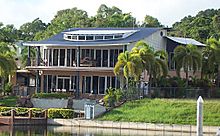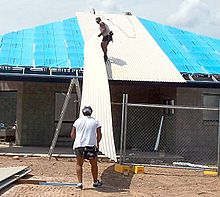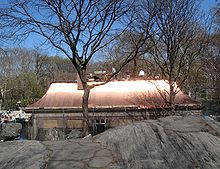- Metal roof
-
A metal roof, often referred to as a tin roof, is a roofing system made from metal pieces or tiles. It is a component of the building envelope.
Contents
History
Metal roof sheeting in the form of corrugated galvanized steel was a great aid to opening up America in its early days. This is still happening today in parts of the developing world.
Advantages
- Light Weight
- Portability
- Durability. The lowest end metal roofing (thin gauge with acrylic or polyester paints) commonly called AG (agricultural) or Utility panels will last 20 to 30 years, which is roughly twice the lifespan of an average asphalt roof. Most metal roofing products today come with warranties from 25 to 50 years. Sheet materials like stainless steel, copper, zinc and aluminium are inherently durable; the oxidization of the base material forms a protective patina. Some modern steel roof sheeting materials are coated with an alloy of zinc and aluminium to give it some of the durability of each of those materials at a lower cost and higher strength than either. Copper and Zinc details have historically been proved to last upwards of 100 years with little or no maintenance. The average life-span of asphalt shingles today (since 2001) is 6 to 9 years,[citation needed] while residential and commercial grade metal roofing usually lasts from 50-100+ years, depending on the type. The coatings and fixings on steel roof sheeting can be designed for different environments including industrial and marine locations.
- Because of their high strength to weight ratio, metal roofs are often used to cover large buildings. The roof of the new Wembley Stadium is an example. It consists of approximately 40,000 sq ft (3,700 m2) steel sheeting.
- Fire and spark resistant.
- Hail resistant.
- Wind resistant.
- Snow shedding: Painted metal roofs are usually snow-shedding. Snow can usually collect when it is fresh and lighter weight. As soon as the ambient temperature rises a few degrees, the snow usually just slides off. For this reason metal roofing is ideal for homes in high latitude or mountain regions.
- Metal is readily recyclable. Aluminum and copper roofing products are available with over 95% recycled content. Most metals can be recycled over and over without losing any valuable properties. Recycling is very efficient. As an example: recycled aluminium only requires 5% of the energy to produce as does new aluminium.
- Design flexibility: Some steel roofing products can be installed over open framing, or on a solid substrate.
- Large sprung curves.
- Rolled bull-nose shapes.
- Energy efficiency. Coatings with high reflectivity like Kynar with "cool roof" pigments commonly save 20-30% on air-conditioning costs due to reflecting away much of the sun's heat. Increases the thermal efficiency of buildings in high temperature areas with its cool-roof paints and high emissivity.
- Labor efficient
- Most metal roofing products require very little or no maintenance.
- Metal roof sheets can be used equally well in cladding the sides of a buildings. Often the same TR-36 profile in two colours will be used to do both roof and sides of a building.
Disadvantages
- Care must be taken on large roofs to provide for thermal expansion and movement.
- Movement caused by differences in temperature may cause objectionable noises in some roofs; for example, curved roof surfaces. However, this is not a common occurrence.
- Care must be taken with all metal roof products to avoid the use of incompatible materials. Dissimilar metals can cause unexpected and rapid corrosion.
- Metal refining and production and transport of metal roof components can be energy-intensive and is almost always a non-local activity. On the other hand, metal roofing products can often be recycled, and the process is relatively clean and energy efficient. Even 200 year-old Copper, for example, can be easily and inexpensively recycled. Some of the metals that are used today, such as Aluminum and Copper, routinely contain over 80% recycled content.
- While metal roofs are expensive, rising oil prices have made metal roofs more affordable in relation to asphalt shingles (oil is a principle ingredient in asphalt shingles). At around one dollar per square foot for colored metal sheets in 29 gauge thickness (as of March 2011), brought metal roof prices close, or equal to asphalt shingles.[citation needed]
Applications
- The material used in metal roofing is versatile and durable. It can be used on residential, commercial, industrial or agricultural buildings. The same material used for metal roofs can be used for siding. There are many different profiles and styles available to fit most every building situation.
- One may combine shapes for aesthetic impact. Using the same material and same color with different shapes can have an impact on "curb appeal" and building value. Alternatively, different metals can be used to create interesting colour combinations.
Metal roofing in new construction
Metal roofing is ordered per piece, whether an individual sheet, a piece of trim, or ridge material. In new construction, proper estimating results in very little waste. Sheets can be ordered at exact lengths, requiring less jobsite modifications.
Metal roofing in remodeling
Metal roofing is usually easily applied over an existing roof. In situations where reducing the cost of labor is essential, it can be helpful to have this option.
Material types
- Corrugated galvanized steel. This describes the original product that was wrought iron–steel sheet coated with zinc and then roll formed into corrugated sheets. This product is still used today in most areas. The newer push of modern architecture and "green" products has brought these products back to the foreground.
- A blend of zinc, aluminium and silicon-coated steel, sold under various trade names like "Zincalume", "galvalume", etc. Sometimes left in the raw zinc finish, but more widely used as a base metal under factory coated colors.
- Metal tile sheets. These are usually painted or stone-coated steel.
- Stainless steel. Available for harsh conditions and/or as a distinctive design element. Usually roll-formed into standing seam profiles; however, shingles are available.
- Aluminum. One of the longest-lasting metals, but somewhat expensive compared to steel products. Aluminum roofs are very lightweight, corrosion-resistant, have high natural reflectivity and even higher natural emissivity, increasing a building's energy efficiency. Aluminum products with Kynar paints easily last over 50 years. The newest innovation is anodizing of the aluminium coil stock for use in architectural details and standing seam panels. The anodized layer is intimately bonded the metal and is not normally subject to weathering and wear.
- Copper. Expensive for a roofing material. Usually used for flashing or smaller, highly detailed areas such as entryways and bays. At the Lyle Center for Regenerative Studies copper is used for regenerative principles of sustainable design: if the building were to be dismantled the copper could be reused because of its high value in recycling and its variety of potential uses.
- Stone coated steel. Panels made from zinc/aluminium-coated steel with acrylic gel coating. The stones are usually a natural product with a colored ceramic coating.
- IBR or Inverted Box Rib. A low-cost corrugated square-fluted iron roofing material used mainly in the South African market. It can be commonly found on anything from industrial sites to low-income shacks.
Coating
Many different types of coatings are used on metal panels: anti-rust, waterproofing, heat reflective. They are made of various materials such as epoxy, ceramic and, more recently, materials developed through nanotechnology.
Metal sheet roofs are very affordable, durable, and quick to install, which makes their use extremely popular in the construction of commercial and industrial buildings. The major problem with metal roofs in warm weather is that they absorb and retain enormous quantities of heat. In non-air-conditioned buildings, this translates directly into high building envelope heat loads, temperature and moisture build-up. In air-conditioned buildings, it means higher energy costs as the air-conditioning has to fight the heat that builds up during the day, even when the sky is overcast (ultraviolet rays, the major source of heat from solar radiation, will penetrate clouds). Because buildings with metal roofs are hotter than the things around them, they contribute to the urban heat island effect. A metal sheet roof in tropical countries, for example, can reach a temperature above 75°C / 167°F.
Ceramic coatings are the most popular heat reflective coatings applied on metal sheet roofs worldwide. The technology is several decades old and was initially developed by NASA for the American space program. Most ceramic coatings are made from regular paint, with ceramic beads mixed in as an additive. Although they reflect, on average, 75% to 85% of solar radiations, their performance tends to plummet by 30+% after a few years because of dirt build-up. Their composition and thickness (from 500 to 1,000 micrometres) can cause cracks to appear, and the color selection is very limited — mainly white with a matte finish. Because of this, their application is mostly limited to industrial and commercial buildings. However, when the cost of the investment is the main issue, they are an affordable choice for insulating metal sheet roofs.
Nanotechnology solar reflective coatings are efficient heat-reflective coatings that can be applied on roofing materials. They are radiant barriers which increase in performance exponentially with the surface's heat, making them perfect for application on metal sheet roofs. Heat load on buildings with metal sheet roofs is typically reduced by 30%, which instantly improves the building's energy-efficiency and caps heat build-up. Developers can take advantage of the affordability and wide availability of metal roofs while transforming them into a high performance heat shield. Traditional under-roof insulation such as PU foam or PE foam can provide additional insulation.
This new generation of nanotechnology coatings adds value and benefits to metal sheet roofs:
- It extends their lifespan: Since the metal expands and contracts less due to lower temperature variations, less stress is caused on bolts and joints. The risk of leaks is reduced, as is the need for maintenance;
- Coated metal sheet roofs are cool and reduce the urban heat island effect;
- Some nanotechnology coatings also include titanium dioxide, which makes them self-cleaning. Metal sheet roofs in industrial areas with lots of dust will remain clean longer and are less sensitive to acids (such as the ones used in cooling towers). In coastal areas, these coatings protect the metal sheet from marine salt.[citation needed]
Maintenance
- A metal roof graded "AG" or "Utility" will need recoating once the factory finish wears off, or corrosion will occur. These paints are commonly acrylic or polyester based. Roof coatings are the preferred material since they are able to stay elastic and withstand the thermal cycling that occurs in metal roofs.
- Roofing materials made from stainless steel, zinc or copper will rarely require maintenance over their lifetime. Any required maintenance is usually due to design or installation mistakes. Otherwise, these materials commonly last over a century.
- Metal roofing with long life polymer coatings like Kynar should not normally require maintenance until the coating fails. These products have been used for over half a century now in the U.S. and few installations have failed. They should be considered lifetime products.
See also
- Metal Roofing Alliance
- Corrugated galvanised iron
- Cool roof
- Green building
- Metal Building Manufacturers Association
References
External links
- Metal Roofing Alliance
- Metal Construction Association
- The Metal Initiative
- Tin Roof Installation Typical Cost
- Canadian Sheet Steel Building Institute - CSSBI
- CSSBI website dedicated to information on Residential Steel Roofing in Canada
- MRM Directory of Metal Roofing Contractors and Consumer Information resource
Categories:- Roofs
- Building materials
Wikimedia Foundation. 2010.




